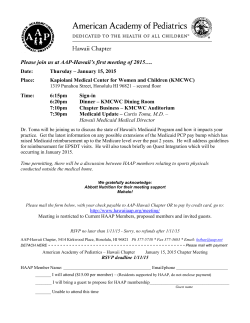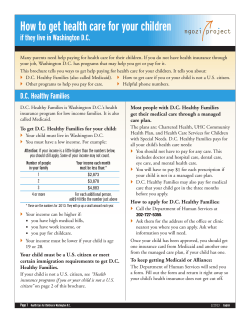
Understanding ACOs in Minnesota, Marie Zimmerman
Understanding ACOs in Minnesota MARIE ZIMMERMAN M I N N E S OTA D E PA R T M E N T O F H U M A N S E R V I C E S CHW ALLIANCE JUNE 5, 2014 Why transformation is needed • State budget pressures Medicaid program and other payers of health care. • Provider financial incentives do not encourage reducing cost and improving quality of care – volume vs. value. • Provider innovation to lower cost and improve quality is often penalized, not supported. • Health outcomes for Medicaid enrollees and other populations need improvement. • Care should be centered around patients and their families. Moving toward value-based incentives • Addressing these challenges will require important changes in provider payment and methods of delivering care • Key roles need to be played by all — consumers, employers, providers, health plans, government and other — to effect this transformation • Payment systems should: • Give providers the freedom and support necessary to foster innovation within the delivery system so that they can determine the most efficient and effective means of providing and improving health. • Provide the opportunity to replicate these innovative care models across the state of Minnesota. Impetus for Accountable Care Organizations Impetus for ACOs Desired Outcomes • Develop payment approaches to create incentives for value not volume • Shift risk and rewards closer to point of care to foster local accountability • Realize return on federal and state investments • Improve access to care, outcomes and information for the enrollee • Value = Better Quality + Lower Cost/“The Triple Aim” • Integrated prevention, wellness, and community services • Coordinate care across care cycle • Data to monitor utilization, compare and share locally and across states • New reimbursement structures, including incentives that encourage integrated care models Slide provided by Center for Health Care Strategies (CHCS) Accountable Care Organization** • A group of health care providers, with collective responsibility for patient care that helps coordinate services – delivering high quality care while holding down costs* • Innovation lies in the flexibility of their structure, payments and risk assumption (i.e., how much “skin in the game” they have in terms of controlling costs and improving quality) • Likely to include PCPs, specialists, and likely a hospital, and other provider and community agreements/partnerships. May need the ability to administer payments, set benchmarks, measure performance, and distribute savings *Robert Wood Johnson Foundation, http://www.rwjf.org/en/topics/search-topics/A/accountable-care-organizationsacos.html **Accountable Care Organizations: A new model for sustainable innovation, Deloitte Center for Health Solutions Slide provided by Center for Health Care Strategies (CHCS) Key Issues for ACOs 1. Identifying a feasible payment model Shared savings/risk Per member per month payments Global budget Bundled payments for episodes of care 2. Building atop existing delivery system reform efforts Patient-centered medical homes Health homes (Medicaid, Section 2703 of ACA) Dual eligibles integration Slide provided by Center for Health Care Strategies (CHCS) Key Issues for ACOs, Cont’d 3. Requiring core provider capabilities Patient stratification Patient-centered care management and coordination Population health management Data infrastructure and analytics 4. Engaging providers, communities, and patients Program planning processes Governance structure Provider criteria Ongoing mechanisms for input Slide provided by Center for Health Care Strategies (CHCS) Key Issues for ACOs, cont’d 5. Including unique high-cost populations Dual eligibles General assistance and expansion populations 6. Defining the scope of services Medical services Behavioral health Long term supports and services Social services 7. Selecting appropriate quality metrics Align with existing programs Measure targeted outcomes Tailor metrics to sub-populations patients Tie payment to quality Slide provided by Center for Health Care Strategies (CHCS) Key Issues for ACOs, cont’d 8. Supporting provider capabilities Learning collaboratives ACO coaches Training sessions IT/data supports 9. Aligning with other payers Medicare Shared Savings and Pioneer ACOs Commercial TCOC/ACO arrangements State Innovations Model 10. Partnering with CMS CMS Concept papers for key components Identifying appropriate regulatory approach Slide provided by Center for Health Care Strategies (CHCS) National ACO models Medicare Shared Savings Program (CMS) Eligible providers, hospitals, and suppliers participate in ACOs to improve the quality of care for Medicare Fee-For-Service (FFS) beneficiaries and reduce unnecessary costs. Advance Payment ACO Model provides supplemental support from CMMI to physician-owned and rural providers for start-up resources to build the infrastructure (e.g., staff, improving information technology systems, etc.) Pioneer ACO Model (CMMI) For early adopters of ACOs Designed to support organizations with experience operating as ACOs or in similar arrangements in providing more coordinated care to beneficiaries at a lower cost to Medicare. The Pioneer ACO Model will test the impact of different payment arrangements in helping these organizations achieve the goals of providing better care to patients and reducing Medicare costs. Slide provided by Center for Health Care Strategies (CHCS) Minnesota’s ACO Models Minnesota Medicaid ACOs Integrated Health Partnerships (IHP) Hennepin Health Integrated Care System Partnerships (ICSP) Commercial ACO/TCOC Agreements Health care providers and systems participate in a range of different delivery and payment arrangements aimed at improving the Triple Aim May include performance based on outcomes/quality and cost; varying levels of financial risk from shared savings to sub-capitation Many use MN Community Measurement TCOC metric and quality measures Arrangements can be across multiple population (self-insured, commercial and government) for some health plans Minnesota’s Approach to Medicaid ACO development Define the “what” we seek, rather than the “how” Provide multiple opportunities for innovation under a framework of several models Allow for local flexibility and innovation under a common framework of accountability Framework of accountability includes: Models based on, and with accountability for, total cost of care TCOC) Robust and consistent quality measurement Models that drive rapidly away from the incentive “to do more” Models that drive rapidly towards increasing levels of integration Three Examples Minnesota Medicaid ACO model: Integrated Health Partnerships (IHP) Previously the Health Care Delivery System (HCDS) demonstration Hennepin Health: a Safety Net ACO Integrated Care System Partnerships (ICSPs) Example 1: Minnesota’s Medicaid ACO Demonstration: IHP “The Minnesota Department of Human Services shall develop and authorize a demonstration project to test alternative and innovative health care delivery systems, including accountable care organizations that provide services to a specified patient population for an agreedupon total cost of care or risk/gain sharing payment arrangement.” (Minnesota Statutes, 256B.0755) IHP Process and Timeline Started with an RFI process, to gather input Developed and issued initial RFP in summer 2011 Responses received were broadly representative of geographic and organizational structure 6 provider systems, serving ~100,000 Medicaid enrollees, started in our IHP model in January 2013 3 additional provider systems began in 2014, for a total of ~145,000 Medicaid enrollees currently being served Released an updated RFP in February 2014 seeking additional providers to begin in January 2015 Minnesota’s Medicaid ACO Demo (IHP): 145,000 enrollees total IHP Geographic area Size (# Attributed) CentraCare Central MN, north of Minneapolis/St. Paul 11,037 Children’s Hospital Minneapolis/St. Paul 16,066 Essentia Health Duluth/NE MN 30,485 FQHC Urban Health Network (10 FQs) Minneapolis/St. Paul 23,757 Hennepin Healthcare System/HCMC Minneapolis/St. Paul 24,558 Mayo Clinic Rochester/SE MN 5,985 North Memorial Minneapolis/St. Paul 3,824 Northwest Health Alliance (Allina/HealthPartners) Minneapolis/St. Paul 12,194 Southern Prairie Community Care Marshall/SW MN 17,947 Provider Characteristics/Requirements IHP providers must Deliver the full scope of primary care services. Coordinate with specialty providers and hospitals. Demonstrate how they will partner with community organizations and social service agencies and integrate their services into care delivery. Have flexibility in governance structure and care models to encourage innovation and local solutions. Accountability Framework • Providers contract with DHS under one of two models: Virtual IHP or Integrated IHP. • The models include the same framework but have different financial arrangements. • The goal was to ensure broadest possible participation and available options. • The agreements are 1-year contracts that renew annually for the 3-year demo period. Accountability for Total Cost of Care The IHP is accountable for its attributed Medicaid enrollees’ Total Cost of Care (TCOC) Both fee-for-service (FFS) and managed care (MCO) recipients attributed TCOC is defined as subset of Medicaid services health care organizations can reasonably be expected to impact. IHP may elect to add excluded services. Generally includes inpatient, outpatient, physician/professional ,pharmacy, certain mental health and chemical health services Generally excludes dental, supplies, transportation, long term services and supports Existing provider payment for services persists during the demo, with shared savings/loss payments made annually based on risk-adjusted TCOC performance Patient’s Included IHP (Attribution) Patient attribution is based on where the patient had the most visits using health care claims data; goal is for attribution to reflect established patient/provider relationship. o Attribution is based primarily on health care homes (HCH) and primary care provider (PCP) relationships. o Patients still maintain freedom of choice, no “opt out” required. o IHP receives monthly attribution roster of people for whom they are accountable. All Medicaid populations are included except for people dually eligible for Medicare and Medical Assistance. Accountability for Quality/Patient Experience IHP performance on core set of measures based on existing state reporting requirements – Minnesota’s Statewide Quality Measurement and Reporting System (e.g. optimal diabetes, asthma, and vascular care; depression remission) Core includes 7 clinical measures and 2 patient experience measures, across both clinic and hospital settings IHPs have flexibility to propose alternative measures and methods Performance on quality measures impacts the amount of shared savings an IHP can receive; phased in over 3-year demo Example 2: Hennepin Health “Safety-net ACO” Population focus: adults on Medicaid with incomes below 133% FPG ~ 8,600 Integrated county model; health care, behavioral health, social services Opportunity for savings outside the Medicaid program to county services Hennepin county: Minnesota’s largest county (Minneapolis) Example 3: Integrated Care System Partnerships (ICSPs) Initiative within Minnesota Senior Heath Options/Senior Care+ (MSHO/MSC+) and Special Needs Basic Care (SNBC) managed care programs for seniors and people with disabilities, designed to align with statewide HCH, SIM and Medicaid ACO provider payment reform initiatives Expands and builds on Medicare/Medicaid MCOs and provider contracting arrangements and experience; Leverages Medicare involvement in State payment reforms Encourages improved health outcomes and choice of care setting Encourages long-term care provider involvement Encourages increased coordination of physical and behavioral health 30 MCO/Provider ICSP proposals accepted for implementation for January 2014, with additional ICSPs required for 2015 Opportunities for CHWs in ACOs Contribute to ACO performance on the Triple Aim: Health care expenditure savings Quality measures/health outcomes Patient/Consumer Experience How can CHWs help ACOs achieve their goals? Better understanding of communities/populations they serve Act as a member of the care team to provide the connection between clinical and community services Trust of the client to facilitate consumer/patient-provider communication and education Savings achieved can help finance CHWs in ACOs Next Steps Minnesota’s SIM grant builds on IHP and other ACOs in the market SIM funding for CHWs and other emerging professions Expansion to additional populations (duals, complex) Increasing importance placed on partnership with non- traditional health care providers and services and community involvement Strong emphasis on integration of acute care and other care settings and long-term services and supports (more global community responsibility) Contact Marie Zimmerman Health Care Policy Director Minnesota Department of Human Services Phone: (651) 431-4233 Marie.Zimmerman@state,mn.us
© Copyright 2025











